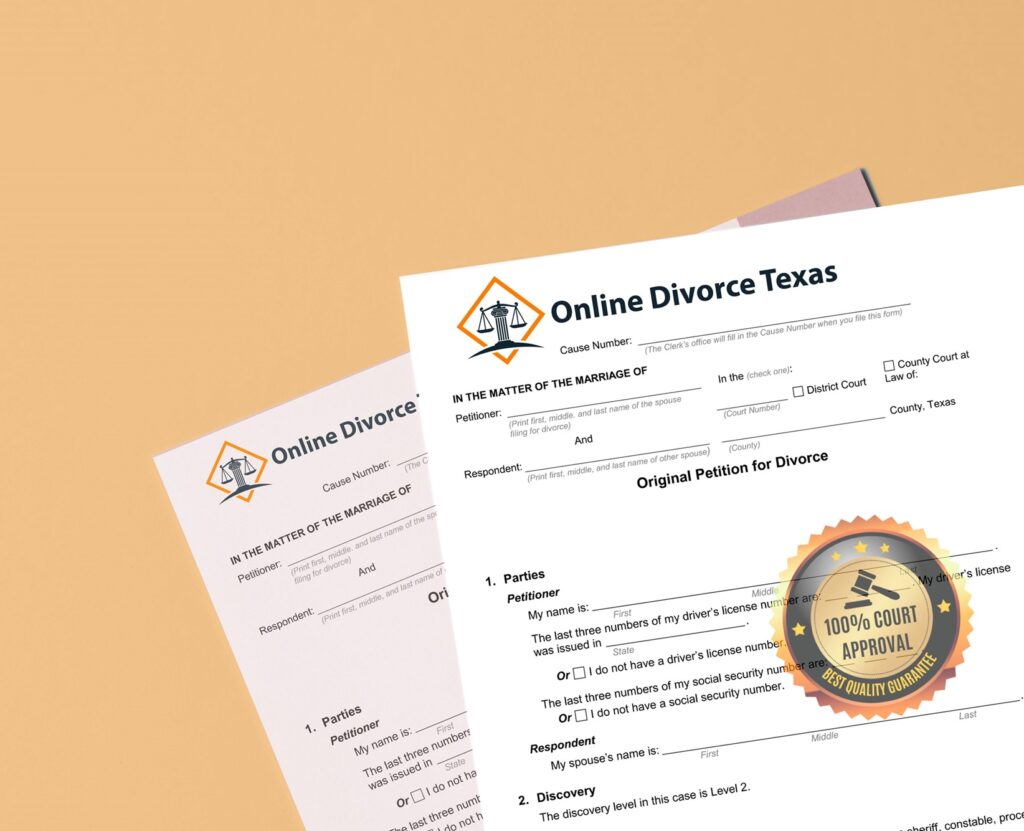The divorce process in Texas depends on different factors, such as whether you have children and if your spouse plans to contest the case. However, irrespective of the type of divorce you are filing for, there are legal processes that will be common and various factors that you will have to account for in order to end your marriage legally.
In order to avoid problems and delays in the process, you have to be aware of the mandatory Texas divorce procedures. There will be a few in each of the divorce steps, and you need to follow them carefully.
Step 1. Determine What Type of Divorce You’re Filing For
Before you start looking for legal paperwork, you need to determine which type of divorce you qualify for. You can do it simply by determining whether you and your spouse can agree on the following questions:
- How to divide assets and debts?
- What type of custody will each of you have?
- Who will pay child support, and what would the sum be?
- Will alimony be paid? Whom to, how much, and for how long?
If there is no way you can reach an agreement on your own or through mediation, you will have to file for a contested divorce. This will necessitate hiring lawyers and will make the whole process lengthy, costly, and very stressful.

If you have or are willing to make a mutually satisfactory agreement on all of the above, filing for an uncontested divorce with or without a family attorney would be an option. Such type of marriage dissolution can be finalized within the shortest time permissible by state laws and for under $1,000.
Even though breaking the news may be difficult, if you want to terminate your marriage amicably, it is best to wait until you are ready to begin the divorce process. In this way, you can have a more straightforward court process and talk about all the issues that need to be settled before the divorce can be filed.
If you refuse to tell your spouse about your decision, it most likely means that you are ready for a contested case. In this scenario, they will be officially notified that you have initiated a case during the service process.
Step 2. Determine Your Grounds for Divorce
Both no-fault and fault-based grounds for divorce are recognized in Texas. According to TFC 6.001-6.007, the reasons for marriage dissolution can be:
- Insupportability due to discord and conflicts that make reconciliation between parties impossible.
- Cruelty of either spouse towards the other which makes further cohabitation untenable.
- Adultery.
- A conviction for committing a serious crime, imprisonment for one year, and non-pardon by the court.
- Abandonment with the intention of deserting the spouse for one year or more.
- Living separately for at least 3 years.
- Confinement of either party in a mental hospital for 3 years or more, provided that improvement of the condition is unlikely or there is a high probability of relapse.
The only no-fault ground for divorce in the state is insupportability, while the other 6 reasons are considered fault-based and must be proven in court by providing solid evidence.

Step 3. Find Case-Specific Forms
To start a divorce process, you need to find and prepare the packet of forms that you will file. There are dozens of forms that are required for each specific case. The most common forms to file are:
- Original Petition for Divorce
- Civil Case Information Sheet
- Information on Suit Affecting the Relationship
- Standard Possession Order

You will need additional forms depending on your divorce decisions and family situation. For instance, if you’re going to change back to the maiden name, request an order withholding your spouse’s income for child support payments, or want to modify a standard custody order. In order to find out what forms suit your case, you need to consult with the lawyer or review and research all the paperwork that might be required.
Step 4. Fill Out the Divorce Papers

Getting ready to file, you need to have all the information on your hands to speed up the process of filling out divorce papers. There are several documents you need to submit to the court to start a lawsuit. When preparing paperwork, make sure you have your marriage certificate, as you will have to indicate the date of your marriage. Additionally, you’ll require the data about your:
- Address
- Employment
- Income and expenses
- Financial accounts
- SSN
- Driver’s license
- Separate and joint property, etc.
Finally, you will need to provide detailed information about your minor children, if any.
To file for divorce, you will have to prepare:
- Original Petition for Divorce. You need to submit this document to the court to start the dissolution of marriage process. Its form will vary depending on whether you have children and whether your marriage is same-sex.
- Civil Case Information Sheet. It is used to report your basic data and the type of case you are filing for.
- Information on Suit Affecting the Family Relationship. In this form, you must identify the type of order and fill in the information about the petitioner, respondent, and children involved, if any.
In addition, you may need other case-specific forms, for example, a Statement of Inability to Afford Payment of Court Costs to confirm that your income is insufficient to pay the filing fee.
Step 5. Meet Eligibility Requirements
You must have lived in the state for at least 6 months prior to filing. As per the county, the minimum residency requirement is 90 days (TFC 6.301).
If you are a member of the armed forces, you can also start a divorce in Texas provided that:
- It has been your or your spouse’s home state for at least 6 months.
- One of the parties lived in the county where you are filing for 90 days.
If you are a permanent resident of the state but have changed your living place due to service or accompanying your spouse who is a service member, this time will be considered as spent in Texas (TFC 6.303).
Individuals living outside the state or country may also submit the paperwork for marriage dissolution in Texas if their spouse meets the residency requirements (TFC 6.302).

Step 6. File Petition for Divorce with the Appropriate Court
The first step in filing for divorce is determining whether you meet the residency requirements of the state and county. To file for divorce in Texas, you must make two copies of your paperwork and bring them to the county court clerk. They will then assign the number to your case, take the original versions, and give you the stamped copies back to serve your spouse.
In order to file for marriage dissolution in Texas, you must pay the filing fees, which are around $300 depending on the court and county that you file in. However, if you have financial difficulties, you may get the fees waived if the court orders it after reviewing your Statement of Inability to Afford Court Costs.
Where to File for Divorce in Texas?
In Texas, you have to file the documents in the county where you or your spouse reside. Divorce procedures in Texas can be initiated only if the court has jurisdiction over your case, meaning that one of you should be domiciled in the state.
Step 7. Serve Your Spouse with Divorce Papers

In order to participate in the process, your spouse has to be officially notified that the divorce has been initiated, even if you have already discussed it.
Serving divorce papers means that the documents you filed with the court have to be delivered to your spouse for them to review and agree or disagree with the terms you outlined, as well as be aware of the process in general. Serving divorce papers in Texas is an essential step, without which you cannot proceed with your marriage dissolution. It needs to be conducted as soon as you file and be performed according to the state laws.
Divorce forms in Texas can be served in several ways:
- Personally, by a constable, sheriff, or other person assigned by the court.
- By the process server in person or by certified mail.
How to Serve Divorce Papers?
Papers can be served personally, by mail, and by email or social network (with special permission). Please note that “personally” means by another person (not you) who is qualified to do it in the state. You should start the serving process as soon as you file the paperwork with the court. It usually takes a few days for the papers to be served.
Can I Serve Divorce Papers Myself?
You can serve the papers personally only if your case is uncontested and your spouse will sign a Waiver or an Answer. A court may allow you to complete the process of service by other means, via substituted service, if the person who first tried to do it could not, for some reason, reach your spouse. However, as stated, there should be a server who would try to pass the documents to your ex first.
Your spouse should receive a copy of each Texas divorce document that you have filed initially. Additionally, provide them with Waiver and Answer forms.
How Much Does It Cost to Serve Divorce Papers?
In case you ask the sheriff or constable to serve the documents, you must pay approximately $50 – $100. The private process server charges around $75 – $160, depending on the turnaround. A lot will depend on the county where you order such services and where your spouse lives.
How to Serve Divorce Papers Without an Address?
First of all, you should try to find the location of your spouse by asking their family, friends, and employer, or co-workers about it. If you still cannot determine the address, you can ask the court to let you serve the documents by posting or publication.
How Does the Court Know That the Other Side Has Been Served?
As soon as your ex is served, they have to officially respond by filing a Respondent’s Original Answer or the Waiver form with the court within the given deadline.
Step 8. Wait 60 Days After Serving the Other Party

As soon as the service step is completed, you must wait 60 days to pass, as this is a mandatory waiting period in Texas. After that, you will be able to arrange a hearing date. The countdown of the waiting period begins the day after the Petition for Divorce is filed.
According to TFC 6.702, you can avoid the mandatory waiting period under two conditions:
- Your spouse has been convicted of violence against you or members of your family.
- You have a valid protective order or a court order for emergency protection that was issued based on findings of domestic violence committed against you during the marriage.
The presence of a 60-day waiting period means that you will not be able to end your marriage earlier except for the extraordinary circumstances indicated above. However, this does not guarantee that you will get a divorce immediately after 60 days are over. Sometimes, spouses have to wait longer; it depends on the workload of the court and other case-specific factors.
Step 9. Go to Trial (Only if Needed)

The final hearing is one of the last steps of your divorce process. You need to schedule a court date after a state-mandated 60-day waiting period. In certain divorce lawsuits, this period may be waived, and you need to engage your lawyer in the process to see if that is possible.
What happens in a divorce trial mainly depends on whether you reached an agreement with your spouse. The final hearing for divorce will be rather quick if it is uncontested. You will need to bring your paperwork and answer questions of the judge, if any.
If your case is contested, your and your spouse’s lawyers will take the lead and present evidence, call witnesses, and do everything in their power to help you reach the desired outcome. Lawyers may try to settle certain issues before the trial to speed up the process and leave fewer disputes at the court’s discretion.
What Happens if I Don’t Want to Go to Trial?
Irrespective of the type of divorce you filed for, you and your ex have to be presented at the final trial because you will have to answer the judge’s questions. Settling divorce out of court in Texas is possible when you make and file a Settlement Agreement, but you will have to be present in front of a judge at least one time, one way or another. If you have no children and your case is uncontested, you may ask the court it is possible not to go to a hearing or get a prove-up hearing in Texas.
Step 10. Finalize the Divorce

The very last step of the divorce process is its finalization. Your marriage dissolution is considered official when the judge signs the Final Decree, and you file it with the clerk.
When you got your divorce decree back, you should bring it to the clerk, and once the divorce is official, make sure that you and your ex comply with the conditions stated in this document.
After the Decree is issued and filed with the clerk, your divorce is final. However, you or your lawyers will have to help you with some of the next steps concerning documents transferring property rights, dividing financial accounts, etc.
When Can I Change My Name?
You can ask the judge to restore your maiden name by filing an Order Restoring Name Used Before Marriage prior to the final hearing. Alternatively, you can change it later after divorce.
How to Prepare for the Divorce Process in Texas

So that the marriage dissolution does not become too stressful and extended, you should prepare for it in advance. To begin with, get ready yourself mentally; the divorce can be physically and emotionally exhausting and result in a strained relationship with your future ex.
Next, take care of your financial assets. You should think about where you will live during the divorce, open a separate bank account, and consider the need to request the issuance of temporary orders by the court.
Let’s analyze your steps in preparation for divorce in more detail.
Copy Important Documents
First of all, you need to make sure that the originals of your documents are kept in a safe place. Make several copies of them in case your spouse might somehow access them. Even if you secured them well and it will not happen, this will save your time in the future when you file your case. It is also advisable to scan your documents, such as passports, to create a digital archive, which you can access any time you need.
Protect and Access Credit
Financial security is an essential aspect for a person who has decided to end their marriage. Change passwords on the credit cards that you own. It is especially important for couples who have previously shared such passwords with each other. It is also a good idea to set up extra security on your online accounts.
Change Passwords
Even if you still trust your ex, it is a good thing to change the credentials on your online accounts before you inform them about your decision to end a marriage. Divorce is a difficult process, and not every person can go through such hardship without making emotionally charged decisions. While you might believe your spouse will remain rational, it is always worth protecting yourself from potential damages, especially when they are easily preventable.
Create an Inventory of Household Items
It will be very convenient for you in case you have to move out, and you will be sure that none of your belongings are missing or stolen. Moreover, this will help you determine which items need to be divided in the course of your divorce. You may also download some home inventory applications to keep the list intact and add or remove items from it easily.
Remove Personal Items
If you have a lot of valuable things that belong personally to you, it is a good idea to remove them to some safe place. For example, it can be your close friends or parents’ house. However, make sure that these things are only yours; otherwise, your ex may accuse you of stealing them in court. These might be assets you owned before getting married, something you inherited, or gifts, even from your spouse.

Create your free account to see if you’re eligible to file for online divorce in Texas. Complete all paperwork from the comfort of your home, with no hidden fees.

